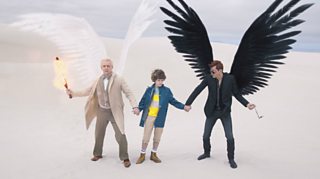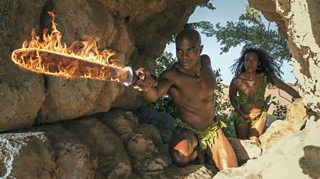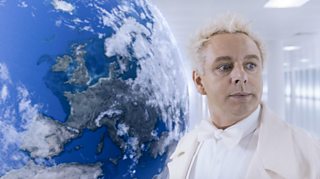
We spoke to Jenna Powell, Visual Effects Producer at Milk VFX, about how you create the end of the world.
How do you film the end of the world?
With the sheer volume and variety of VFX required for Good Omens - 650 VFX sequences - the key was to be in constant conversation with co-author of Good Omens and showrunner Neil Gaiman and director Douglas Mackinnon throughout the entire process, both in pre and post-production as well as during the shoot.
Thankfully they were happy to be readily available to us throughout so we could always ask them questions and keep the team moving forward. We had constant access to Neil, which was wonderful! He would often quote from the book to advise us creatively as we planned and developed the VFX to help bring their vision to life on screen. It also meant we were able to show him concept designs the team were developing in the studio, such as Satan and the wings for Crowley and Aziraphale, whilst our VFX Supervisor Jean Claude Deguara was on set with him in South Africa.
The planning and development time in pre-production was essential. During this time we broke down all six scripts with Douglas Mackinnon to plan the methodology for the VFX; working out and refining how to best use VFX to support the storytelling. It was a very collaborative process - often we would work with him to decipher and work out how to translate Neil’s vision in words to life on screen and what was workable.
We created everything from creatures (Satan exploding up out of the ground; a Kraken; a Hellhound; a demon and a snake) to environments (Heaven – a penthouse with views of major world landmarks, a busy Soho street); feathered wings for Michal Sheen’s angel Aziraphale and David Tennant’s demon Crowley and a CG Bentley, in which Tennant’s Crowley hurtles around London. We also had a large effects team working on a whole range of effects over the six episodes - from setting the M25 and the Bentley on fire; a flaming sword; a call centre filled with maggots to a sequence in which Crowley travels through the internet at high speed!
Everything needed to have its own unique look and feel but as the story moves swiftly from one scene to the next in the build up to the apocalypse, we couldn’t dwell on any one effect for too long. We’d have a scene with a major effect but it wouldn’t be repeated again so we had one chance to make sure the character or effect was immediately identifiable for the viewer.
Equally, it was important to Neil Gaiman that the CG elements did not stand out too much, despite the fantasy nature of the subject matter. We needed to ensure the worlds and characters were always kept grounded in reality. A good example is how we approached Heaven and Hell. These key locations are essentially based around an office block!
Nothing too fantastical. But they are, as you would expect, completely different and deliberately so. Hell is the basement, which was shot in a disused abattoir in South Africa whilst Heaven is a full CG environment located in the penthouse with a panorama view over a cityscape featuring landmarks such as the Eiffel Tower, the Shard and the Pyramids.

How did you create the Angel and Demon wings?
Crowley and Aziraphale both have large majestic wings when seen in their real forms. Originally, our concept artist designed black bat-style wings for Crowley but Neil Gaiman preferred to have feathers for both the demons and angels.
We developed the wings based on swan-wing anatomy and built them digitally using the correct bone and feather structure, so that they could be animated realistically and broke them down into primary, secondary and covert feathers. Our ‘grooming’ team then replicated the swan feathers using bespoke software. Our look development artists ensured there was colour variation, with every feather a slightly different hue to make them look and move realistically.
Fine detail helped Aziraphale’s white feathers on screen, while Crowley’s black wings benefited from added iridescence. Getting the right balance of iridescence on the black feathers and then ensuring the white feathers had enough detail and variation to stand out was challenging. We spent time in the look development stages tweaking them. When we got to actual shot production we worked very closely with Neil and our groom and creature effects team to get a look that he and Douglas were really happy with - that would feel a realistic part of the actors bodies as they progressed through the scenes.
A lot of people have been trying to track down Aziraphale’s bookshop, can you let us in on its secret location?
There are rumours it may be hidden somewhere in the streets of London’s Soho! But we will let you into the secret… the Soho Street where the bookshop is located in Good Omens, was based on Berwick Street.
Here’s how it was created:
- Production designer Michael Ralph created a set comprising of a two-block street exterior constructed up to the top of the first story, with the complete bookshop - inside and out - standing on the corner.
- Four 20x20-foot mobile green screens helped our environment team complete the upper levels of the buildings and extend the road into the far distance. We photo scanned both the set and the original Berwick Street location, combining the reference to build digital assets capturing the district’s unique flavour, for scenes during both the day and night.
Douglas Mackinnon wanted crowds of people moving around constantly. So on shooting days, crowds of extras thronged the main section of street and a steady stream of vehicles turned in from a junction partway down. Areas outside this central zone remained empty, enabling us to drop in digital people and traffic without having to do takeovers from live-action performers and cars. Milk had a 1,000-frame cycle of cars and people that they dropped into every scene. We devised it so the real cars pulled in round the corner and there was always a bit of gridlock going on in the back to create visual interest.

Which was your favourite visual effect to create?
The CG Bentley without a doubt!
The digital Bentley featured in scenes showing the car tearing around London and the countryside at 90 miles per hour. Ultimately David Tennant’s Crowley drives through Hell fire on the M25, it catches fire and burns continuously as he heads towards the site of Armageddon.
The production located a real Bentley 3.5 Derby Coupe Thrupp & Maberly 1934, which we photo scanned and modelled in intricate detail. We introduced subtle imperfections to the body panels, ensuring the CG Bentley had the same handcrafted appearance as the real thing and would hold up in full screen shots, including continuous transitions from the street through a window to the actors in an interior replica car. In order to get the high speed required we shot plates on location from multiple cameras, including on a motorbike to achieve the high-speed bursts. Later production filled the car with smoke and our effects team added CG fire and burning textures to the exterior of our CG car, which intensified as he continued his journey.
Any tips for someone who wants to work in visual effects?
Use every opportunity to draw, design and practice your craft. There is lots of free software and tips you can download such as Blender. It takes a lot of hard work and dedication but harness your passion and keep going and you will succeed.
There are a whole variety of roles from 2D compositing artist to more technical roles such as FX artist; to VFX production which involves project-managing the VFX in a similar role to a TV/film producer. VFX is based around teamwork and close collaboration – so you’ve got to enjoy working in a team for a career in VFX.
How did you start in the visual effects industry?
I began as a production runner on Gerry Anderson’s New Captain Scarlet at Pinewood Studios, which felt like a dream at the time! It was a full CGI re-make of the 1960s series and my first experience working in CG.
I worked on the project for two years and worked my way up to be an episode coordinator. It was a baptism of fire and I had to learn quickly but I gained a huge amount of valuable experience in terms of the process from script to screen. After two years, that production wrapped and I moved to The Mill in central London and my visual effects journey began with Elizabeth I for Channel 4.
Fifteen years later, I’m now at Milk and I’m still in awe of the impact and power visual effects can have. I hope that never ends.
Good Omens is on Βι¶ΉΤΌΕΔ Two and Βι¶ΉΤΌΕΔ iPlayer on Wednesdays at 9pm.
